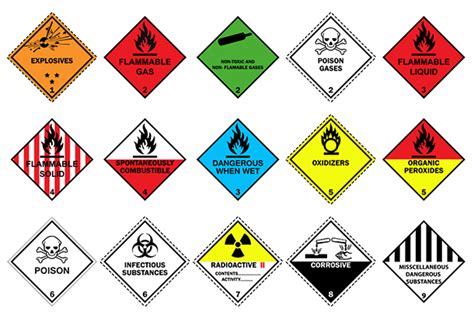The proper use of hazard class labels is crucial for ensuring the safe handling, transportation, and storage of hazardous materials. These labels serve as a visual warning system, communicating the potential dangers associated with a particular substance or product to individuals who may come into contact with it. The primary goal of hazard class labels is to provide a standardized method of identifying hazards, thereby reducing the risk of accidents and exposures.
To understand the importance and application of hazard class labels, it’s essential to delve into the world of hazardous materials and the regulatory frameworks that govern their management. The United Nations (UN) has developed a system for classifying hazardous materials into nine hazard classes, each representing a specific type of hazard. These classes include:
- Explosives (Class 1): Materials that are capable of producing a chemical reaction that leads to a rapid release of gas and heat, often resulting in a blast or explosion.
- Gases (Class 2): Substances that are in a gaseous state at normal temperatures and pressures, which can be compressed, liquefied, or dissolved under pressure.
- Flammable Liquids (Class 3): Liquids that have a flash point below 61°C (141°F) and are capable of igniting easily, burning rapidly, and releasing a significant amount of heat.
- Flammable Solids (Class 4): Materials that are capable of igniting and burning rapidly, often producing a significant amount of heat and flame.
- Oxidizing Substances (Class 5): Materials that can cause or enhance the combustion of other substances, often producing a significant amount of heat and flame.
- Toxic and Infectious Substances (Class 6): Materials that are capable of causing harm or death if ingested, inhaled, or if they come into contact with the skin.
- Radioactive Materials (Class 7): Substances that emit ionizing radiation, which can cause harm or death to living organisms and damage to the environment.
- Corrosive Substances (Class 8): Materials that are capable of causing damage or destruction to living tissues, metals, and other materials through chemical reactions.
- Miscellaneous Dangerous Goods (Class 9): Substances that do not fit into any of the other hazard classes but are still considered to be hazardous, such as environmentally hazardous substances.
Each of these hazard classes has its own set of labeling requirements, which are designed to provide a clear and concise warning of the potential hazards associated with a particular substance. The labels typically include a combination of colors, symbols, and text that indicate the level of danger and the necessary precautions to be taken when handling the material.
It's worth noting that while hazard class labels are an essential component of hazardous materials management, they are only one part of a larger system. Proper training, equipment, and procedures are also necessary to ensure the safe handling and transportation of these substances.
In addition to the UN hazard classes, there are also various national and international regulations that govern the use of hazard class labels. For example, the U.S. Department of Transportation (DOT) has its own set of regulations for labeling hazardous materials, which are outlined in the Hazardous Materials Regulations (HMR). Similarly, the International Air Transport Association (IATA) and the International Maritime Organization (IMO) have their own sets of regulations for labeling hazardous materials for air and sea transport, respectively.
Steps for Implementing Hazard Class Labels
- Identify the hazard class of the substance or product
- Select the appropriate label or marking for the hazard class
- Ensure the label or marking is properly applied to the packaging or container
- Verify that the label or marking is compliant with relevant regulations
- Provide training to personnel on the meaning and application of hazard class labels
In conclusion, hazard class labels play a crucial role in the safe management of hazardous materials. By understanding the different hazard classes and the labeling requirements for each, individuals and organizations can take the necessary steps to prevent accidents and exposures. It’s essential to remember that hazard class labels are just one part of a larger system, and proper training, equipment, and procedures are also necessary to ensure the safe handling and transportation of hazardous materials.
What are the primary purposes of hazard class labels?
+The primary purposes of hazard class labels are to provide a visual warning of the potential hazards associated with a substance or product, to identify the level of danger, and to indicate the necessary precautions to be taken when handling the material.
How many hazard classes are there, and what do they represent?
+There are nine hazard classes, which represent different types of hazards, including explosives, gases, flammable liquids, flammable solids, oxidizing substances, toxic and infectious substances, radioactive materials, corrosive substances, and miscellaneous dangerous goods.
What are the regulatory frameworks that govern the use of hazard class labels?
+The regulatory frameworks that govern the use of hazard class labels include the United Nations (UN) system, the U.S. Department of Transportation (DOT) Hazardous Materials Regulations (HMR), and the International Air Transport Association (IATA) and International Maritime Organization (IMO) regulations for air and sea transport, respectively.



